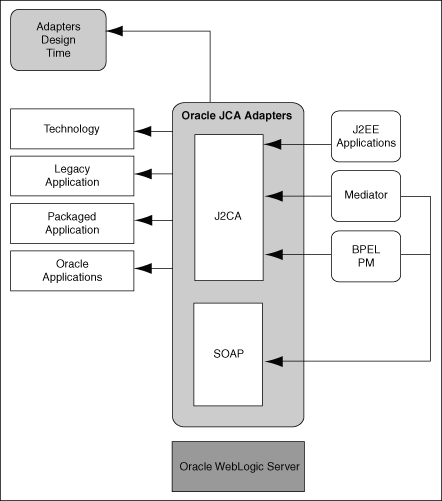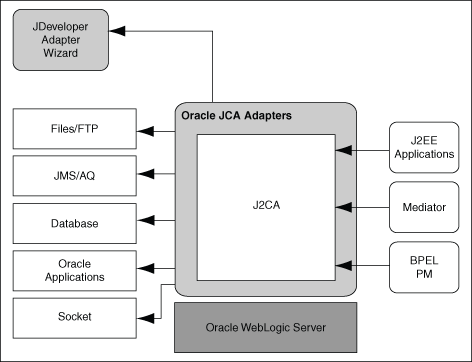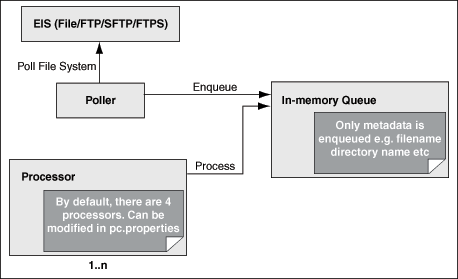Following are the requirements, assumptions and actions needed to install the Transaction Manager based on Oracle BPEL Process Manager.
The sample configuration is as follows:
Assume that MATaddr is address of the Transaction Commiter and MATport is port on which TC is listening, and that MZWDaddr is address of the Concurrency Control Module and MZWDport is port on which CCM is listening.
Then, after a standard installation of these modules, a sample configuration is as follows:
Individual parameters in the configuration file have the following meaning:
Requirements
- Oracle BPEL Process Manager,
- JDeveloper - used when the business processes are installed,
- The Transaction Commiter - there is known URL at which it is/will be available.
- The Concurrency Control Module (optionally) - there is known URL at which it is/will be available
Installation steps
Installation of Transaction Manager based on Oracle BPEL Process Manager:- First, installation file must be downloaded and unzipped.
- Then, project located in the file:Example1 directory must be imported to JDeveloper
- This project includes BPEL processes which initiate TC and CCM transactions. These processes should not be modified.
- The third BPEL process is an example that illustrates how transactional extensions can be used in the BPEL process. On the basis of this process, you can create your own BPEL process which will use the extensions in the imported project.
- At the end, it is necessary to modify the settings in the configuration file in the library: Example1/Example/SCA-INF/lib/mzt1.0.jar. This modification is described below, in the Configuration section.
Uninstallation
Uninstallation can be done by removing all components of the project related to the Transaction Manager. This will probably be a significant part of the project, therefore, we propose to delete the entire project and save your own processes, or other important files.Configuration
Project can function as the Transaction Manager if it is configured correctly. Configuration consists in entering the appropriate addresses in the configuration file. These addresses are used during communication performed by extensions. Configuration file configuration.conf there is in the archive: Example1/Example/SCA-INF/lib/mzt1.0.jar. In this file, an entries that relate addresses of coordinators (TC and CCM) and initiators (which initiate transactions coordinated by TC and CCM), installed in the BProCORE environment should be updated. The addresses of the coordinators should be known after their installation. After the first deployment of the project is possible to verify the addresses of the initiators. These initiators are the business processes MZTInitiator and TFPInitiator.The sample configuration is as follows:
Assume that MATaddr is address of the Transaction Commiter and MATport is port on which TC is listening, and that MZWDaddr is address of the Concurrency Control Module and MZWDport is port on which CCM is listening.
Then, after a standard installation of these modules, a sample configuration is as follows:
ActivationServiceAddress=http://MATaddr:MATport/axis2/services/\
MATActivationCoordinator
StandardCoordinationType=http://cs.put.poznan.pl/itsoa/OB2-5/mat/2009/11/
E2PCServiceAddress=http://MATaddr:MATport/axis2/services/\
MATParticipantEnhanced2PC
MzwdActivationAddress=http://MZWDaddr:MZWDport/axis2/services/\
ActivationService
CompletionInitiateAddress=http://192.168.96.1:8001/soa-infra/\
services/default/Example/mztinitiator_client_ep
MzwdTfpInitiatorAddress=http://192.168.96.1:8001/soa-infra/\
services/default/Example/tfpinitiator_client_ep
- ActivationServiceAddress
- Address of TC activation service.
- StandardCoordinationType
- The standard type of coordination (not modify this value).
- E2PCServiceAddress
- Address of the protocol service of Enhanced2PC, used by the participant of transactions. This service is used for nested transactions.
- MzwdActivationAddress
- Address of CCM activation service.
- CompletionInitiateAddress
- Address of the protocol service of Enhanced2PC, used by the initiator of TC transactions after deployment on Oracle BPEL Process Manager (MZTInitiator business process),
- MzwdTfpInitiatorAddress
- Address of the protocol service of TransactionFinallizationProtocol, used by the initiator of CCM transactions after deployment on Oracle BPEL Process Manager (TFPInitiator business process).







